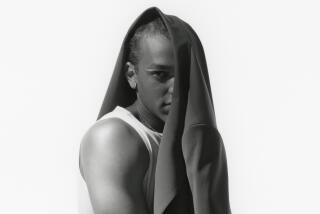Prints: Trend Is to Mix, Not Match
- Share via
Forget the age-old notion that clothes should match .
If you can call patterns the medium, then mixing is the message here.
The idea is to combine two or three or more patterns at once. Polka dots with paisleys. Pin stripes with graphics. Plaids with florals. Checks with more checks.
It’s a personal style of dressing practiced on the streets of Los Angeles by men, women and children--a style in which all the standard rules of decorum seem to have been tossed into a blender or food processor.
Indeed, if there are any rules to this mode of dress, they are perhaps derived from the dress code of somber businessmen who--in a more subtle vein--can skillfully mix, say, a glen-plaid suit with a striped shirt and a polka-dot tie--with all of the parts working in harmony.
New York menswear designer Alan Flusser points out that men have been concerned with “melding” patterns since the ‘30s. But the key to successful pattern-on-pattern dressing, Flusser says, is scale--even if you’re not a Brooks Brothers man.
“A bold stripe should be worn with a smaller print. You have to know how to temper the patterns so they don’t fight,” he says.
Jim Olarte, co-owner of Locals Only, a vintage-clothing store in Laguna Beach, agrees. Combining pieces like an early ‘60s madras shirt, a ‘50s slubbed jacket and a contemporary Giorgio Armani paisley necktie requires a deft touch.
“Subtle twists and blends make it look right,” he says, adding that if you’re not careful “you can end up looking like a tourist on Newport Beach.”
Some of the inspiration for mixing prints no doubt comes from European designers such as Jean Paul Gaultier, Daniel Hechter, Kenzo and Emmanuel Ungaro--all believers in pattern mixing.
But Gary Sipe, an art historian and painter specializing in faux finishes, who is partial to wearing more than one paisley, sees the roots of his dressing elsewhere than in fashion.
“Matisse,” Sipe says, “always mixed a million different patterns at once.”


